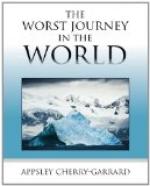“In the smallest and craziest ships they plunged boldly into stormy ice-strewn seas; again and again they narrowly missed disaster; their vessels were racked and strained and leaked badly, their crews were worn out with unceasing toil and decimated with scurvy. Yet in spite of inconceivable discomforts they struggled on, and it does not appear that any one of them ever turned his course until he was driven to do so by hard necessity. One cannot read the simple, unaffected narratives of these voyages without being assured of their veracity, and without being struck by the wonderful pertinacity and courage which they display."[7]
The position in 1840 was that the Antarctic land had been sighted at a few points all round its coasts. On the whole the boundaries which had been seen lay on or close to the Antarctic Circle, and it appeared probable that the continent, if continent it was, consisted of a great circular mass of land with the South Pole at its centre, and its coasts more or less equidistant from this point.
Two exceptions only to this had been found. Cook and Bellingshausen had indicated a dip towards the Pole south of the Pacific; Weddell a still more pronounced dip to the south of the Atlantic, having sailed to a latitude of 74 deg. 15’ S. in longitude 34 deg. 16’ W.
Had there been a Tetrahedronal Theory in those days, some one might have suggested the probability of a third indentation beneath the Indian Ocean, probably to be laughed at for his pains. When James Clark Ross started from England in 1839 there was no particular reason for him to suppose that the Antarctic coast-line in the region of the magnetic Pole, which he was to try to reach, did not continue to follow the Antarctic Circle.
Ross left England in September 1839 under instructions from the Admiralty. He had under his command two of Her Majesty’s sailing ships, the Erebus, 370 tons, and the Terror, 340 tons. Arriving in Hobart, Tasmania, in August 1840, he was met by news of discoveries made during the previous summer by the French Expedition under Dumont D’Urville and the United States Expedition under Charles Wilkes. The former had coasted along Adelie Land, and for sixty miles of ice cliff to the west of it. He brought back an egg now at Drayton which Scott’s Discovery Expedition definitely proved to be that of an Emperor penguin.
All these discoveries were somewhere about the latitude of the Antarctic Circle (66 deg. 32’ S.) and roughly in that part of the world which lies to the south of Australia. Ross, “impressed with the feeling that England had ever led the way of discovery in the southern as well as in the northern region, ... resolved at once to avoid all interference with their discoveries, and selected a much more easterly meridian (170 deg. E.), on which to penetrate to the southward, and if possible reach the magnetic Pole."[8]




